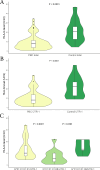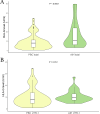The role of HLA-G in primary biliary cholangitis and response to therapy
- PMID: 40799641
- PMCID: PMC12339529
- DOI: 10.3389/fimmu.2025.1585535
The role of HLA-G in primary biliary cholangitis and response to therapy
Abstract
Introduction: Primary biliary cholangitis (PBC) is a rare autoimmune liver disease involving bile duct damage and fibrosis. This study explores the role of HLA-G, an immunomodulatory molecule crucial for immune tolerance, in PBC pathogenesis and treatment.
Methods: A cohort of 166 PBC patients from Sardinia was compared to 180 healthy controls and 205 autoimmune hepatitis type 1 (AIH-1) patients. Plasma soluble HLA-G (sHLA-G) levels, HLA-G alleles, and 3'UTR haplotypes were analyzed alongside clinical data, including therapy response to ursodeoxycholic acid.
Results: The UTR-1 haplotype was significantly more frequent in PBC patients than in controls (48.2% vs 34.3%, Pc= 0.0018). The extended haplotype HLA-G*01:01:01:08/UTR-1 was also strongly associated with PBC (23.2% vs 12.5% in controls, Pc = 0.008; 23.2% vs 6.6% in AIH-1, Pc= 2.6×10-9). PBC patients exhibited lower sHLA-G levels compared to controls and AIH-1 (9.1 U/mL vs 24.03 U/mL and 13.9 U/mL, respectively). Among UTR-1 carriers, sHLA-G levels were particularly reduced in PBC patients. The HLA-G*01:01:01:08/UTR-1 haplotype correlated with the lowest sHLA-G levels and poorer therapy response (60% vs 24.1%, P = 0.0001).
Discussion: These findings suggest HLA-G variants, especially HLA-G*01:01:01:08/UTR-1, as potential biomarkers for PBC prognosis and treatment outcomes.
Keywords: HLA-G; Sardinia (Italy); autoimmune diseases; primary biliary cholangitis; ursodeoxicholic acid.
Copyright © 2025 Miglianti, Mocci, Littera, Serra, Balestieri, Conti, Pes, Deidda, Lorrai, Mereu, Murgia, Sanna, Mascia, Sedda, Duś-Ilnicka, Cipri, Carta, Lai, Giuressi, Melis, Zolfino, Giglio, Perra and Chessa.
Conflict of interest statement
The authors declare that the research was conducted in the absence of any commercial or financial relationships that could be construed as a potential conflict of interest.
Figures




References
MeSH terms
Substances
LinkOut - more resources
Full Text Sources
Research Materials

